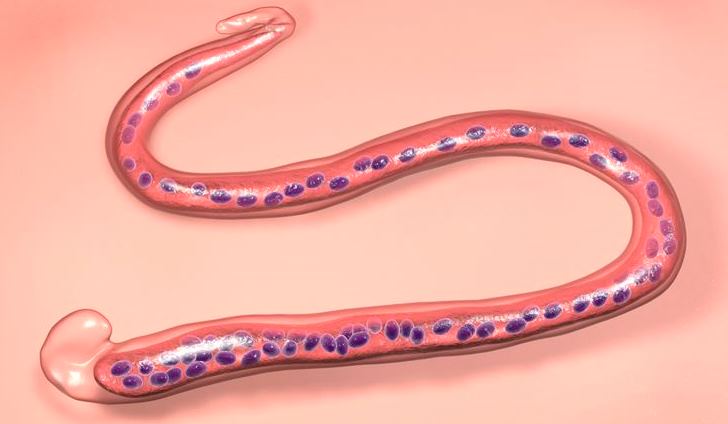Life-Cycle – Pathogenecity And Control Of Wuchereria – Zoology Notes – For W.B.C.S. Examination.
Wuchereria bancrofti is commonly known as filarial worm. This worm causes filariasis in humans. Demarquay first discovered the larval form of this worm; later Wucherer found these larvae in the chylorous urine.Continue Reading Life-Cycle – Pathogenecity And Control Of Wuchereria – Zoology Notes – For W.B.C.S. Examination.
Lewis found them in human blood and Bancroft found the adult females. The name of this worm is given Wuchereria bancrofti in honor of the two scientists Wucherer and Bancroft who made considerable contribution in studying the disease caused by these worms.
Distribution: This pseudo coelomate round worm is spread throughout the world except in Polar Regions. It is prevalent in India, Arabia, Malaya, Korea, japan, Brazil and south pacific islands. It is relatively absent in Europe, North America and Africa.
Habit and habitat: This filarial worm is dreadful human parasite residing in the human blood and lymph. It is digenetic parasite requiring two hosts to complete its life cycle. The two hosts are man and female culex mosquito. The adult worms are harbored in a coiled state in human lymph glands and lymph passage. These worms obstruct the passage of the lymph.
Structure of Filarial worm: The body of adult filarial worm is elongated, narrow, filiform and cylindrical in shape. These worms are creamy white in color. Anterior ends terminate bluntly whereas the posterior end is a little pointed. The male and female worms are found coiled round each other in the lymph vessels.
A mouth with no oral lips is present at the anterior end. The alimentary canal of this worm includes mouth, pharynx, oesophagus, intestine and anus. The anterior part of the pharynx is muscular and the posterior part is glandular. Wuchereria bancrofti is a unisexual worm exhibiting sexual dimorphism.
The female worms are slightly longer and thicker than that of their male counterparts. Each female worm measures around 65-100mm in length and 0.25 mm in diameter. The posterior end of the female is straight and bears anus. The female genital pore also called as vulva is present ventrally at about one third length of the body from the anterior tip.
Male worms are comparatively smaller and thinner than the females. Each male filarial worm measures around 40 mm in length and 0.1 mm in diameter. The posterior end of the male worm s curved bearing cloaca in this region. A pair of unequal penial setae or copulatory spicules is present in cloacal or curved region. Many copulatory papillae are present in the posterior region.
LIFE CYCLE OF WUCHERERIA
Wuchereria is a heterogeneous parasite which completes its life cycle in two different hosts namely man and female culex mosquito.
Life cycle in Man: This cycle is also known as Human Phase. The process of copulation takes place in the lymphatic system of the human. The male and female worms copulate when they are present in the same lymph gland. The female worms are ovoviviparous that is they produce eggs which hatch within the body of the female without obtaining nourishment from it. Numerous microscopic juvenile larvae called microfilariae are released into the lymph.
Each microfilaria is about 0.2 to 0.3 mm in length. It is surrounded by loose cuticular sheath. This cuticular sheath is also known as egg membrane. The surface of this larva is covered by flattened epidermal cells. Its body contains columns of cytoplasm with a number of nuclei. An oral style is present at the anterior end where the mouth develops in the future. Microfilaria also bears the following parts,
- A nerve ring around the pharynx
- Excretory pore
- Renette cells
- Four large germinal cells
- Future anal pore
- Inner cell mass
- Somatic cell mass
The microfilaria after being released into the lymph vessels, enter the blood vessels and circulate with the blood. Ultimately they migrate to the visceral organs and reside in the deeper blood vessels of thorax region. In this thorax region the larvae do not undergo any additional change as further development can happen only inside the intermediate host (mosquito). Thus, these larvae move to the peripheral blood vessels during the night time between 10:00 pm to 4:00 am to suit the feeding habit of the mosquito. This movement of the larvae is called as nocturnal periodicity. During the day time these larvae live in the large deep-seated blood vessels but during night they migrate to the peripheral blood vessels. Hence it can be said that microfilariae show day and night periodicity also known as diurnal rhythm. The microfilariae die if they are not transferred to the mosquito within 70 days. This microfilaria is the infective stage to the mosquitoes.
Please subscribe here to get all future updates on this post/page/category/website


 Toll Free 1800 572 9282
Toll Free 1800 572 9282  mailus@wbcsmadeeasy.in
mailus@wbcsmadeeasy.in



















































































































